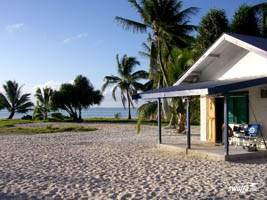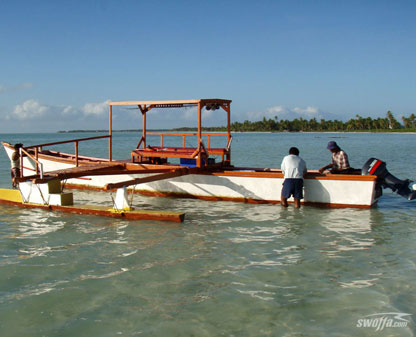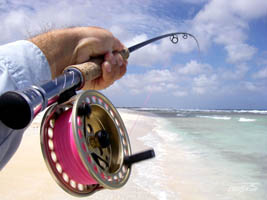Christmas Island is the bomb!
 |
 |
There are actually two Christmas Islands. One is in the Indian Ocean off Western Australia and the other forms part of the Line Islands in the middle of the Pacific. After the war, the britts and yanks thought it would be a perfect place to test their Atom Bombs and now nearly 50 years to the day, armed only with fly rods, we ventured back and proved that Christmas Island is the bomb destination!
Christmas Island (Kiritimati) is situated 1 degree north of the Equator, slightly west of the International Dateline, some 2,000 km South of Hawaii. It's the first inhabited place on earth to experience the New Year and is also the largest coral atoll in the world. Since the early 80's CI has been described as one of the most consistently productive bone-fishing destinations in the world and with hundreds of square km of protected flats that make up the inner lagoon, it's easy to see why. It's a perfect destination for the avid bone-fisher, the water and weather are warm all year round, there's loads of fish and dare I say it, the bone fishing is quite easy. There's so much water and so many flats, at times all you have to do is stand still on the flat and cast as they come past.
Copra and fishing tourism are the main income earners for the local Gilbertese people who inhabit the island and wherever we went, we were greeted with smiles and friendly faces, it was fantastic.
 |
 |
 |
 |
What's a swoffa?
I'm a super keen saltwater fly fisherman and back home in Australia, that's known as a swoffa. Like a lot of fly anglers, I'm happy to be out all day with multiple fly rods casting all types of flies at anything that moves. In Australia, we are completely spoilt with the sheer variety of species and seemingly endless destinations to fish - present me or my mates with the opportunity to cast flies at a variety of species and you have a happy bunch of anglers.
Half of our group stayed for 2 weeks and this gave some of us ample time to really explore the possibilities that CI has to offer. Our group of intrepid swoffas included John Williams, Andy Vockler, Geoff Volter, Paul Meneely, James McDonald, Nick Archibald, Bill Ryder and myself Jono Shales. Corin Smith flew in and joined us for the second week.
Our home away from home
We stayed at The Villages which is the newest lodge on the Island and is currently setup to cater for 8 guests, there are however plans to extend that to 12 with a new cabin currently being built, along with a 3rd boat. The Villages is part of the local Tabwakea Village which is part of the Kiribati Presbyterian Church community. As there were 8 of us, we had the whole place to ourselves and were the first all Ozzie group to stay there.
The Villages is the also the only hotel on the Island that is situated on the shores of the inner lagoon, which means your room is only a stone's throw away from the nearest cruising bonefish. Each day the boats pick you up and drop you off literally from your doorstep. The rooms are very clean and comfortable, each with 2 beds, air-conditioning, a stocked bar fridge, hot and cold running water and plenty of storage space. Food and service was excellent!!
 |
 | |
 | ||
 |
The boats
The boats are locally made, single engine longboats with outriggers - very comfortable and perfect for transporting anglers and gear around the vast lagoon. Each boat comes with two boat dudes who fill the fuel tanks, clean the boat, drop anchor, fall asleep and whatever else it is that boat dudes do.
The boats work really well in the lagoon however it soon became apparent that when we ventured offshore, they were in no way made for chasing fish or casting a fly from. At best, the angler on the bow has to back cast thanks to the outrigger while the angler at the stern can forward cast but has to contend with fuel tanks and a boat driver in his way.
Fly fishing from these longboats was some of the most challenging and difficult fishing that I've ever done. To catch fish, it often meant being able to cast a full fly line from a pitching boat in a 20 knot wind - plus of course there was the language barrier between angler, guide and the boat dude who seemed to have his own agenda.
In total we ended up fishing for six and a half days offshore, in the lee of the island in constant 20 knot offshore winds in a boat with zero safety gear. It's not the safest thing in the world to do, but geez we had some sensational fishing.
 |
The guides

|

|

|
The guides are great. Most will have you onto a fish in no time and the more experienced guides will see fish long before you ever do. Teanaki is the head guide at The Villages. He is a walking encyclopaedia of the flats, his body-clock is connected to the moon and the stars and his understanding and knowledge of the area that he calls home is unbelievable. Interacting with people like Teanaki and learning from the wealth of knowledge that he and the rest of the guides carry in their heads, allows us to become more attuned to our surroundings and ultimately better fly fisherman too.
Bonefish
CI is famous for its bone fishing and there's been reams of bonefish articles that have already covered this. In a nutshell, we all had good fun on the bonefish and each day one of our group would consistently come home with reports of a 6 or 7 pound fish - with a 10 pounder thrown in too. There are so many flats and so much water it's unbelievable. The sheer scale of the place has to be experienced first hand in order to be appreciated. It's true, there are lots of small bones, but there are lots of BIG bones too.
On the southern tip of the Island and only accessible by almost 2 hours in a bouncy truck, is the Korean Wreck. If you want big bones that are easy to see and monster trevally that surf the waves and crash unsuspecting little reef fish, then go there.
6, 7 and 8 wt rods are ideal. Floating lines are the go and stripping baskets proved invaluable too. Any reel that can hold 150m of 20lb backing should be fine. My setup was a fast action 6wt rod that I up-lined with a 7wt bonefish floating line, leader setup was 3ft of 30lb butt section, down to 8ft of 15lb fluorocarbon attached with a triple surgeons knot straight to the fly. Others chose tapered leaders but honestly, it made no difference as we all caught fish.
Flies with colour that matched the colour of the flat seemed to work best, but more importantly was the sink rate of the fly. I ended up using the same pattern (gotcha) in two different weights the entire time and did just fine.
 |
 |
 | |
 | |||
 | |||
 |
 |
 |
 |
Offshore carnage
The offshore possibilities at CI are fantastic. An army of large hungry pelagics inhabit the waters that surround the island - wahoo, sailfish and tuna are around for most of the year and so are the monster GTs that guard the outer reefs. To catch big, fast and unique fish on fly, the envelope needs to be pushed and this often means doing things or going places that others dare not, or simply wont. It's this dogged approach to catching fish with a fly rod that can produce some great results, but it can also lead to a very risky situation as we nearly found out in the second week.
While we were there, the yellowfin tuna were in their hundreds literally tearing the ocean apart. They were spread across multiple schools, some moving fast across the ocean feeding in long lines, while others were ripping through bait balls. It was absolute carnage with hundreds and hundreds of birds in the air making nearly as much noise as the tuna ripping the water apart.
Check out the footage below as Voltzy has the tip of his rod pulled off as a line bunch-up gets wrenched through the eyes, pulling the rod apart. After some good teamwork, the knot was undone and the tip re-attached and he went on to land a respectable 40lb yellowfin tuna.
 |
 | |
 | ||
 |
In the middle of the schools the fish were shoulder to shoulder, all around 40-50 lbs. On the perimeter of the schools the larger solitary fish in the 80-100+ lb category could be seen slowly porpoising, taking their time to feed with their large yellow sickles and dark backs slowly slicing through the surface. There were some massive fish in the schools and at times it would look like a 44 gallon drum was punching holes in the ocean, it was total raw power.
Andy's rod tip bust when his tuna was gaffed too early into the fight. The fish accelerated ripping the gaff from the guide's hand, cutting his hand and in the process busting Andy's rod. The fish swam off with the gaff still stuck in it and continued pulling more line.
 |
 |
|
 | ||
 |
12wt rods with sinking lines seemed to work best in the constantly windy conditions. Although the fish were thick, it took many attempts to get to a point where all the variables were inline and get a hook-up. The first day it took us 5 hours to get 3 fish and just getting a fly into the water proved a challenge in itself. There were so many birds it was like a scene out of Hitchcock's movie 'The Birds', they were everywhere. Once the line did manage to get past the birds and into the water amongst the feeding fish, fast double-handed strips with the rod under the arm seemed to work best.
 |
 | |
 | ||
 |
When hooked they usually run very hard and then head straight down. Leader setup was straight through 60lb so the last thing you want is for slack line to wrap around anything as the fish speeds off ripping line up off the floor and back onto the reel. I will never forget the feeling of the line coming up tight on that first fish, it was awesome power and instantly everything was put to the test. All you can do is hold on as these fish pull line, then dive and leave you to pull them up as the do constant circles below you.
When they're not pulling line, you should be. Hold on tight though, these things pull like steam trains.
That's only half of it!
The second week accounted for even more outrageous offshore action as we risked life and limb chasing hungry pelagics around the ocean in a longboat. We refined our yellowfin tuna chasing techniques, teased up some giant wahoo and land what could possibly be Christmas Island's first Sailfish cast and landed on a fly rod.
Read part 2 here. If you'd like to learn more about this trip or would like to be notified when the second report is up, or would like to be notified on the launch of swoffa.com, please register below.
We invite you to send us your comments or send the link to your swoffing friends, using the forms below.
Thanks from the swoffa.com team and we look forward to bringing you more of the same.
Did you enjoy this article?
Send this article to a friendSend us your comments
Subscribe to swoffa.com
